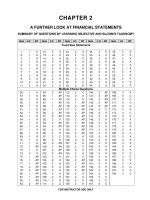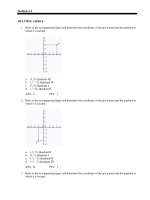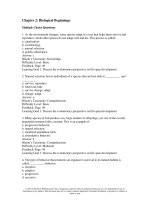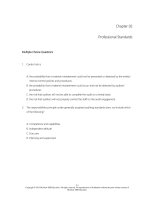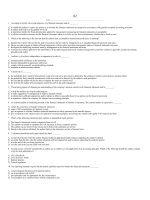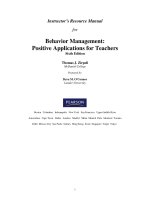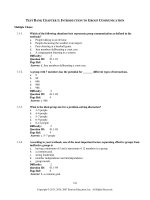Critical care nursing 6th edition urden test bank
Bạn đang xem bản rút gọn của tài liệu. Xem và tải ngay bản đầy đủ của tài liệu tại đây (147.59 KB, 8 trang )
Urden, Stacy, Lough: Critical Care Nursing, 6th Edition
Chapter 2: Ethical Issues
Test Bank
MULTIPLE CHOICE
1. The difference between morals and ethics is that ethics
a. is more concerned with the “why” of behavior.
b. distinguishes the good or right in conduct.
c. is broader in scope.
d. concentrates on the right or wrong of behavior.
ANS: A
Ethics are derived from an evaluation of an action based on a set of standards; morals
are codes of conduct, determining right or wrong actions.
DIF: Cognitive Level: Comprehension REF: {Differences between Morals and
Ethics}
OBJ: Nursing Process Step: General TOP: Ethics
MSC: NCLEX: Safe and Effective Care Environment
2. A client’s wife has been informed by the physician that her spouse has a permanent
C2-3 spinal injury resulting in permanent quadriplegia. The wife states that she does
not want the physician or nursing staff to tell the client about his injury. The client is
awake, alert, and oriented when he asks his nurse to tell him what has happened. The
nurse has conflicting emotions about how to handle the situation and is experiencing
a. powerlessness.
b. moral distress.
c. moral doubt.
d. frustration.
ANS: B
The nurse has been placed in a situation initially causing moral distress and is
struggling with determining the ethically appropriate action to take. Emotions that
follow moral distress can include powerlessness, frustration, and even doubt in the
ability to make an immediate decision.
DIF: Cognitive Level: Comprehension REF: {Moral Distress}
OBJ: Nursing Process Step: General TOP: Ethics
MSC: NCLEX: Safe and Effective Care Environment
3. The critical care nurse can best enhance the principle of autonomy by
Mosby items and derived items © 2010 by Mosby, Inc., an affiliate of Elsevier Inc.
Test Bank
a.
b.
c.
d.
2-2
allowing the client to do as much for himself or herself as possible.
assisting with only those tasks that cannot be done by the client.
providing the client with all information and facts.
guiding the client toward the best choices for care.
ANS: C
Clients and families must have all the information about a certain situation to make an
autonomous decision that is best for them.
DIF: Cognitive Level: Synthesis
REF: {Autonomy}
OBJ: Nursing Process Step: General TOP: Ethics
MSC: NCLEX: Safe and Effective Care Environment
4. Which of the following ethical principles is most important when soliciting informed
consent from a client?
a. Nonmaleficence
b. Fidelity
c. Beneficence
d. Veracity
ANS: D
Veracity is important when soliciting informed consent because the client needs to be
aware of all potential risks of and benefits to be derived from specific treatments or
their alternatives.
DIF: Cognitive Level: Comprehension REF: {Veracity}
OBJ: Nursing Process Step: General TOP: Ethics
MSC: NCLEX: Safe and Effective Care Environment
5. Fidelity includes faithfulness and promise-keeping to clients, and incorporates the
added concepts of
a. confidentiality and privacy.
b. truth and reflection.
c. autonomy and paternalism.
d. beneficence and nonmaleficence.
ANS: A
Confidentiality is a right involving the sharing of client information with only those
involved in the client’s care. Privacy includes confidentiality but goes further to
include the right to privacy of person and personal space, such as ensuring that a client
is adequately covered during a procedure.
DIF: Cognitive Level: Comprehension REF: {Fidelity}
Mosby items and derived items © 2010 by Mosby, Inc., an affiliate of Elsevier Inc.
2
Test Bank
2-3
OBJ: Nursing Process Step: General TOP: Ethics
MSC: NCLEX: Safe and Effective Care Environment
6. Which statement best reflects the concept of allocation of resources within the critical
care setting?
a. Limitations of resources force reexamination of goals of critical care for clients.
b. Care is provided equally to all those who need the resources.
c. Equal access is available for those with the same condition or diagnosis.
d. Technologic advances are available to most of those in a given community.
ANS: A
Limited resources force society and critical care health practitioners to reexamine
goals of critical care for clients.
DIF: Cognitive Level: Comprehension REF: {p 16}
OBJ: Nursing Process Step: General TOP: Ethics
MSC: NCLEX: Safe and Effective Care Environment
7. When deciding whether to withdraw or withhold treatment, it is important to
a. examine one's own beliefs to guide the family to a correct decision.
b. approach the family with honesty and provide clear information.
c. simply follow the advance directive if available.
d. allow the physician to approach the family.
ANS: B
This is a difficult time and the nurse needs to be attuned to the family’s needs by
providing timely information, honesty, and clear treatment options, and by listening to
the family.
DIF: Cognitive Level: Knowledge
REF: {Withholding and Withdrawing
Treatment}
OBJ: Nursing Process Step: General TOP: Ethics
MSC: NCLEX: Safe and Effective Care Environment
8. The Code of Ethics for Nursing provides a framework for the nurse in ethical decision
making. This code
a. is usurped by state or federal laws.
b. allows the nurse to focus on the good of society rather than the uniqueness of the
client.
c. was recently adopted by the American Nurses Association.
d. describes the nurse's role in advocating for client rights and safety.
ANS: D
Mosby items and derived items © 2010 by Mosby, Inc., an affiliate of Elsevier Inc.
3
Test Bank
2-4
The Code of Ethics for Nursing describes the professional role of the nurse in
advocating for and protecting clients' rights to health and safe care.
DIF: Cognitive Level: Comprehension REF: {Figure 2-2}
OBJ: Nursing Process Step: General TOP: Ethics
MSC: NCLEX: Safe and Effective Care Environment
9. Ethical decisions are best made by
a. following the guidelines of a framework or model.
b. having the client discuss alternatives with the physician or nurse.
c. prioritizing the greatest good for the greatest number of persons.
d. careful consideration by the Ethics Committee once all diagnostic data are
reviewed.
ANS: A
To facilitate the ethical decision-making process, a model or framework must be used
so that all involved will consistently and clearly examine the multiple ethical issues
that arise in critical care.
DIF: Cognitive Level: Comprehension REF: {p. 18}
OBJ: Nursing Process Step: General TOP: Ethics
MSC: NCLEX: Safe and Effective Care Environment
10. The first step of the ethical decision-making process is
a. consulting with an authority.
b. identifying the health problem.
c. delineating the ethical problem from other types of problems.
d. identifying the client as the primary decision maker.
ANS: B
Step one involves identifying the major aspects of the client's medical and health
problems.
DIF: Cognitive Level: Knowledge
REF: {p. 18}
OBJ: Nursing Process Step: General TOP: Ethics
MSC: NCLEX: Safe and Effective Care Environment
11. Values clarification can assist the client to clarify his or her own values to facilitate
effective decision making. Which of the following nursing activities is incorporated
into this intervention?
a. Avoid the use of open-ended questions.
b. Use multiple sessions to cross-examine the client to ensure he or she is clear about
personal values.
c. Use appropriate questions to assist the client in reflecting on the situation and what
Mosby items and derived items © 2010 by Mosby, Inc., an affiliate of Elsevier Inc.
4
Test Bank
2-5
is personally important.
d. Encourage members of the health care team to relate how they would make the
decision.
ANS: C
Appropriate questions should be used to assist the client in reflecting on the situation
and what is personally important.
DIF: Cognitive Level: Comprehension REF: {p. 19}
OBJ: Nursing Process Step: General TOP: Ethics
MSC: NCLEX: Psychosocial Integrity
12. Nursing ethics committees often differ from institutional ethics committees in what
way?
a. They do not involve specific client situations.
b. Their recommendations for action are binding.
c. Staff education is an important component.
d. Their primary role is to create policies for the hospital on ethical issues.
ANS: C
Nursing ethics committees provide a forum for nurses to discuss various ethical issues,
serve as a staff resource, and provide education.
DIF: Cognitive Level: Knowledge
REF: {p. 20}
OBJ: Nursing Process Step: General TOP: Ethics
MSC: NCLEX: Safe and Effective Care Environment
13. Institutional ethics committees (IECs) review ethical cases that are problematic for the
practitioner. Major functions of IECs include all of the following except
a. consultation with purely binding recommendations.
b. support and education to health care providers.
c. conflict resolution for ethical dilemmas.
d. recommendations to policy-making bodies.
ANS: A
The IEC can function in a variety of ways, serving as consultants, providing education,
and helping resolve ethical conflicts or dilemmas for health care providers.
Recommendations from the formal IEC may or may not be binding and are relative to
the situation at hand.
DIF: Cognitive Level: Knowledge
REF: {Institutional Ethics Committees}
OBJ: Nursing Process Step: General TOP: Ethics
MSC: NCLEX: Safe and Effective Care Environment
Mosby items and derived items © 2010 by Mosby, Inc., an affiliate of Elsevier Inc.
5
Test Bank
2-6
14. Which of the following is NOT a criteria for defining an ethical dilemma?
a. An awareness of different options
b. An issue in which only one viable option exists
c. The choice of one option compromises the option not chosen
d. An issue that has different options
ANS: B
The criteria for identifying an ethical dilemma is threefold: (1) an awareness of the
different options, (2) an issue that has different options, and (3) the choice of one
option over another compromises the option not chosen.
DIF: Cognitive Level: Knowledge
REF: {p. 18}
OBJ: Nursing Process Step: Assessment
TOP:
MSC: NCLEX: Safe and Effective Care Environment
Ethics
TRUE/FALSE
1. If a treatment achieves a predictable outcome then, by definition, it is NOT futile.
ANS: F
Unless the treatment has shown some benefit to the client, despite having achieved the
predicted outcome, the treatment is still deemed futile.
DIF: Cognitive Level: Knowledge
REF: {p. 17}
OBJ: Nursing Process Step: General TOP: Ethics
MSC: NCLEX: Safe and Effective Care Environment
MATCHING
Match the following terms with their definitions:
a. Beneficence
b. Veracity
c. Justice
d. Objectivity
e. Subjectivity
1. Synonymous with the concept of allocation of resources
2. Analyzes a person’s psychosocial state
3. Preventing harm and promoting the well-being of clients
4. Examining a person’s ability to function
Mosby items and derived items © 2010 by Mosby, Inc., an affiliate of Elsevier Inc.
6
Test Bank
2-7
5. Telling the truth
1. ANS: C
DIF: Cognitive Level: Knowledge
OBJ: Nursing Process Step: General TOP: Ethics
MSC: NCLEX: Safe and Effective Care Environment
REF: {pp. 15-16}
2. ANS: E
DIF: Cognitive Level: Knowledge
OBJ: Nursing Process Step: General TOP: Ethics
MSC: NCLEX: Safe and Effective Care Environment
REF: {pp. 15-16}
3. ANS: A
DIF: Cognitive Level: Knowledge
OBJ: Nursing Process Step: General TOP: Ethics
MSC: NCLEX: Safe and Effective Care Environment
REF: {pp. 15-16}
4. ANS: D
DIF: Cognitive Level: Knowledge
OBJ: Nursing Process Step: General TOP: Ethics
MSC: NCLEX: Safe and Effective Care Environment
REF: {pp. 15-16}
5. ANS: B
DIF: Cognitive Level: Knowledge
OBJ: Nursing Process Step: General TOP: Ethics
MSC: NCLEX: Safe and Effective Care Environment
REF: {pp. 15-16}
MULTIPLE RESPONSE
1. Place the following steps in ethical decision making in the order in which they should
be carried out:
a. Identify the health problem.
b. Implement decisions.
c. Identify the decision maker.
d. Define the ethical issue.
e. Evaluate actions and decisions.
f. Gather additional information.
g. Examine moral and ethical principles.
h. Explore alternative options.
ANS: A, B, C, D, E, F, G, H
The steps in ethical decision making mirror those in the nursing process.
DIF: Cognitive Level: Synthesis
REF: {p. 18}
OBJ: Nursing Process Step: General TOP: Ethics
MSC: NCLEX: Safe and Effective Care Environment
COMPLETION
Mosby items and derived items © 2010 by Mosby, Inc., an affiliate of Elsevier Inc.
7
Test Bank
2-8
1. A professional ethic is based on three elements: __________, __________, and
__________.
ANS:
the professional code of ethics, the purpose of the profession, the standards of practice
of the profession
The three elements that form the basis for a professional ethic are the existence of a
professional code of ethics, a defined professional purpose, and an identified standard
of practice.
DIF: Cognitive Level: Comprehension REF: {p. 17}
OBJ: Nursing Process Step: General TOP: Ethics
MSC: NCLEX: Safe and Effective Care Environment
2. _____ _____ educate the staff to problems and provide for discussion identifying
potential problems and determining actions that can be taken to decrease or prevent the
incidence of a problem.
ANS:
Ethics rounds
Ethics rounds at the unit level regarding patients educate the staff to problems and
serve to be “preventive” when facilitated appropriately. During the discussion,
potential problems may be identified early and actions can be taken to decrease or
prevent the incidence of a problem.
DIF: Cognitive Level: Comprehension REF: {Ethics Rounds and Conferences}
OBJ: Nursing Process Step: General TOP: Ethics
MSC: NCLEX: Safe and Effective Care Environment
Mosby items and derived items © 2010 by Mosby, Inc., an affiliate of Elsevier Inc.
8
